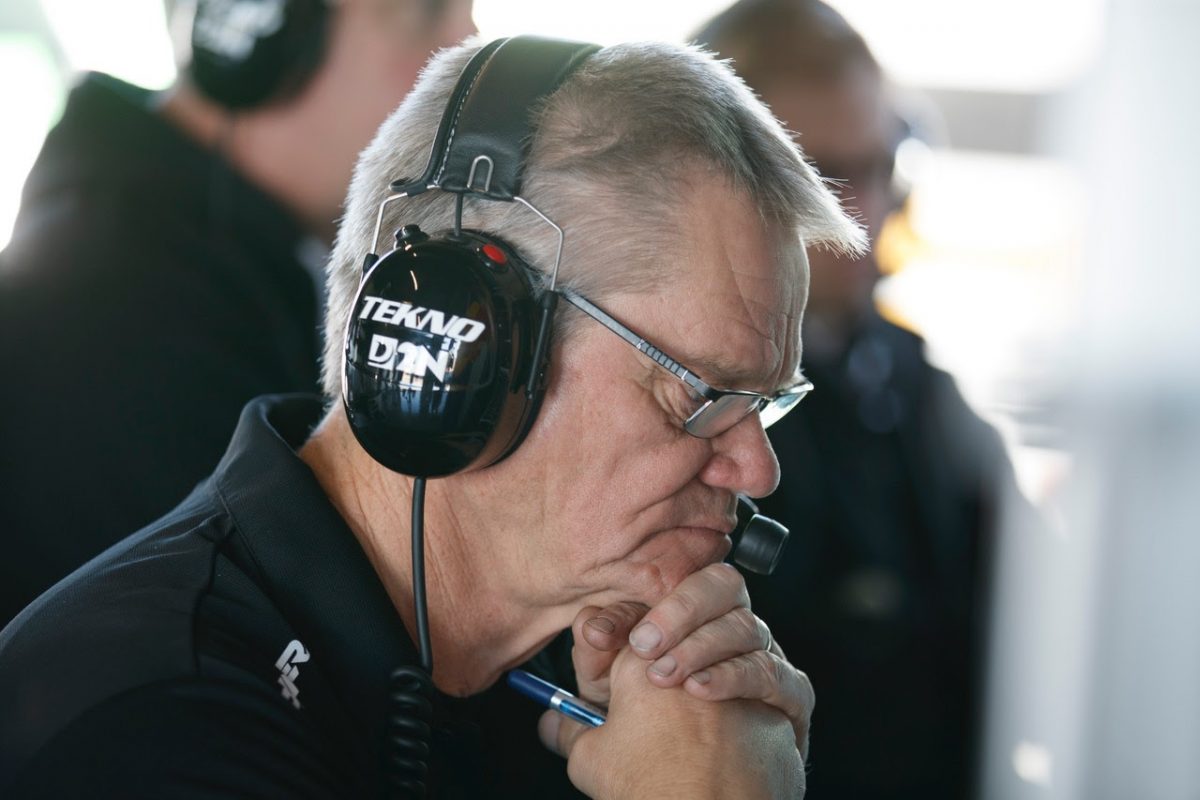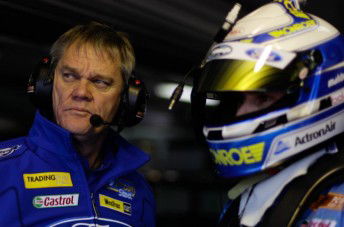

A chance encounter in Lismore in the mid-1980s set Campbell Little’s career down an extraordinary path.
Now part of the Supercars technical department, where he works alongside Adrian Burgess, there is little the former motorcycle racer hasn’t done.
Little grew up in Lismore, in Northern New South Wales, where he took on a motorcycle mechanic apprenticeship alongside his own competition.
He raced trials, speedway, and almost everything from 350cc production bikes to Superbikes.
“I was also preparing bikes for local wannabes,” he told Speedcafe.com.
That was before he met speedway world champions Bruce Penhall and Bobby Schwartz as the pair visited Lismore.
“I think it was just a display, to be honest, because they didn’t normally race solo bikes there,” Little recounted.
The pair had blown an engine and needed it repaired, and happened across the shop at which Little was working.
“They came, we managed to repair it, welded up pistons and did a bodgy job and repaired it.
“They guys said, ‘Do you want to come to Brisbane with us?’ and I went, ‘Oh, okay’.
“Then they said, ‘Do you want to come to South Australia with us?’ and I said, ‘Okay’.
“’Do you want to come back to the UK with us?’ I went, ‘Okay’.
While abroad he joined Honda Great Britain, which opened doors globally.
Back in Australia he worked with Mal Campbell, while abroad he had the opportunity to take in the Isle of Man TT.
“I actually entered and raced one year at the Isle of Man,” Little said.
“Anyone could enter and it was just so you could do it.
“The funny thing was I went back there some years later with Joey Dunlop, actually, with Honda.

“I appear in a movie called V Four Victory, I think it’s called. It was made way back in the ’80s, and my head pops up from behind the seat of one of his motorbikes.”
It was one of a host of opportunities Little had which saw him work all over the world.
“I contracted to Honda Racing Corporation and I don’t think I spent a weekend at home,” he explained.
“We’d do racing in Japan, they’d send you off to do stuff all over Europe, and then we’d do the Australian Superbike series and various other things as well.
“We also did the Finke Desert Rally, the Bol d’Or 24 Hour, did the Paris–Dakar, did all sorts of support stuff.
“They (Honda) basically went, ‘You go there and do that’.
“It was a real good grounding because you drove the truck, you did everything; there was only two or three or four of you.”
Little’s path crossed with Jeremy Burgess, who would go on to work with Mick Doohan and Valentino Rossi.
The pair worked together for a year before Little opted to return to Australia, ending his time in the two-wheeled world at the end of 1985.
With the economy in decline, Little engineered himself a move into four-wheeled competition courtesy of a connection to Frank Lowndes.
“Where we were doing the dyno work on our bikes was Frank Lowndes’ workshop in northern Melbourne,” Little said.
“In conversations I went, ‘How do I get into cars?’, not that I was over bikes, but bikes at that time were sort of on a decline; the Yen was going up, all these other things.
“He introduced me to Frank Gardner, so then I went across to Frank, who was in Sydney in the JPS BMWs.”
As had happened with Honda, the relationship with Garder opened doors internationally for Europe with BMW.
“I started doing my degree as an external student whilst working for Frank Gardner,” Little said.
“It worked out quite well because the Germans also wanted an engineer as such and, other than Frank, I put my hand up.
“So I got then sent to Germany and got indoctrinated into the German way, got introduced to Schnitzer, and things went from there.”
In 1986, Little was working with Schnitzer in the World Touring Car Championship, while continuing to work with Gardner.
The following year he engineered the Class 2 Bathurst 1000 win for Jim Richards and Tony Longhurst.

Little was engineer at the Benson & Hedges BMW M3 in 1992 when Formula 1 world champion Denny Hulme died.
“I was engineering that car and talking to him on the radio as he passed away,” he said solemnly.
He continued contracting with Schnitzer abroad before an opportunity arose in Toyota New Zealand.
“I also did a whole lot of stuff for Toyota New Zealand when they went to ethanol in their TRS (Toyota Racing Series),” he continued.
“I built a couple of cars for Bruce Miles.
“I ran a young bloke by the name of Jason Richards in New Zealand, and I introduced another guy by the name of Murphy too. He came over to Australia in one of Bruce’s cars.
“That was in the same year that we had the two-litre cars and the two-litre championship and the nightmare of various other things.”
While working in New Zealand Little had remained in contact with Ross Stone, having worked together with Kevin Waldock.
Little also crossed paths with Jimmy Stone, who had a spell with Longhurst’s BMW outfit.
It meant, when the pair opted to set up their own team in the mid-1990s, Little was one of the first they called.
“They rang me and I was their first employee,” Little recounted.
“We did everything from wiring the cars to… Well, at that time I was in charge of their engines and electronics.”
He remained with Stone Brothers on and off from 1995 until the end of 2003, though there was a brief interlude for a return to the UK.
“The interesting thing was that Ross kind of let me go quite a bit,” he explained.
“In the years before that, the Toyotas that we’d bought and raced in Asia, I’d actually brokered that deal with a guy by the name of James Kaye and Roland Dane.
“In the same time I went over to the UK and went through their factories.
“Then one day out of the blue this guy rings me up and says, ‘We want to race our two-litre cars at Bathurst. Do you want to come along and do whatever?’
“That was Ian Harrison and Triple Eight UK.
“The first year, they had James Kaye in the car, but we also had (Greg) Murphy and Russell (Ingall) in one, and we had (Peter) Brock and another one of the partners.
“They actually invited me back to the UK to work with them the following year, which I did, but it was kind of the end of the really flashy two-litre Touring Car Championship.
“So I had a hiatus from SBR, then I came back, did one more year of the two-litre Bathurst with them, and then, near the end of 2003, Roland rang me up and said, ‘I’m buying a team. Do you want to come work for me?’
“So, I was with them until 2009.”
His decision to leave Triple Eight was a result of a conversation with the former CEO of Vodafone, Cameron Levick, who went on to become CEO of Supercars.
Little was charged with the Car of the Future project, but looking back suggested “That, politically, didn’t turn out to be a very good move from me or for Cameron”.
“I think it was in May that year, splittergate, I called it, where nobody actually protested but some of them came and said, ‘Oh, we don’t like that front bar support on Triple Eight’s car’,” he said.
“I washed my hands of it, basically.
“I said, ‘Look, I designed it. I have to walk away from it,’ (and) left it up to Frank (Adamson).
“But it just blew out of control completely, where I was getting death threats and phone calls at two o’clock in the morning.
“So I said, ‘I don’t need this. This wasn’t what I was promised’.
“Cameron resigned, it was just a clusterf**k, so I walked away from it.”

Soon after he found himself at Ford Performance Racing working with Mark Winterbottom, who he’d previously run in Formula Ford and the Development Series.
There have also been spells with Dick Johnson Racing, Tekno Autosports, and he’s even popped up working with McElrea Racing preparing GT cars.
A decade on from Car of the Future, he’s now back at Supercars in the technical department where he’s played a role in the homologation testing of the Holden ZB Commodore and Ford Mustang.
For a young kid who found his way into motorcycle racing almost out of necessity, it’s an extraordinary tale.
“My father passed away and my mum couldn’t even drive a car, so that was it.
“My first mode of transport was a motorbike, my sister’s first mode of transport was a motorbike, because we couldn’t afford anything else, I suppose,” he explained.
“My brother had moved away, my sister had moved away, and my mum said, ‘Well, you’re finished school: you’re out’.
“So I got a job because it was all I could do.
“A little town in Lismore, it was 25,000 people or something, you didn’t look any wider than that, but it was amazing what happened in the next four years.
“Anyway, it’s been good. It’s been quite entertaining for a motorcycle mechanic from some little town.
“I’m no expert at anything. It has just morphed from one to another. I met some good people.”




















Discussion about this post